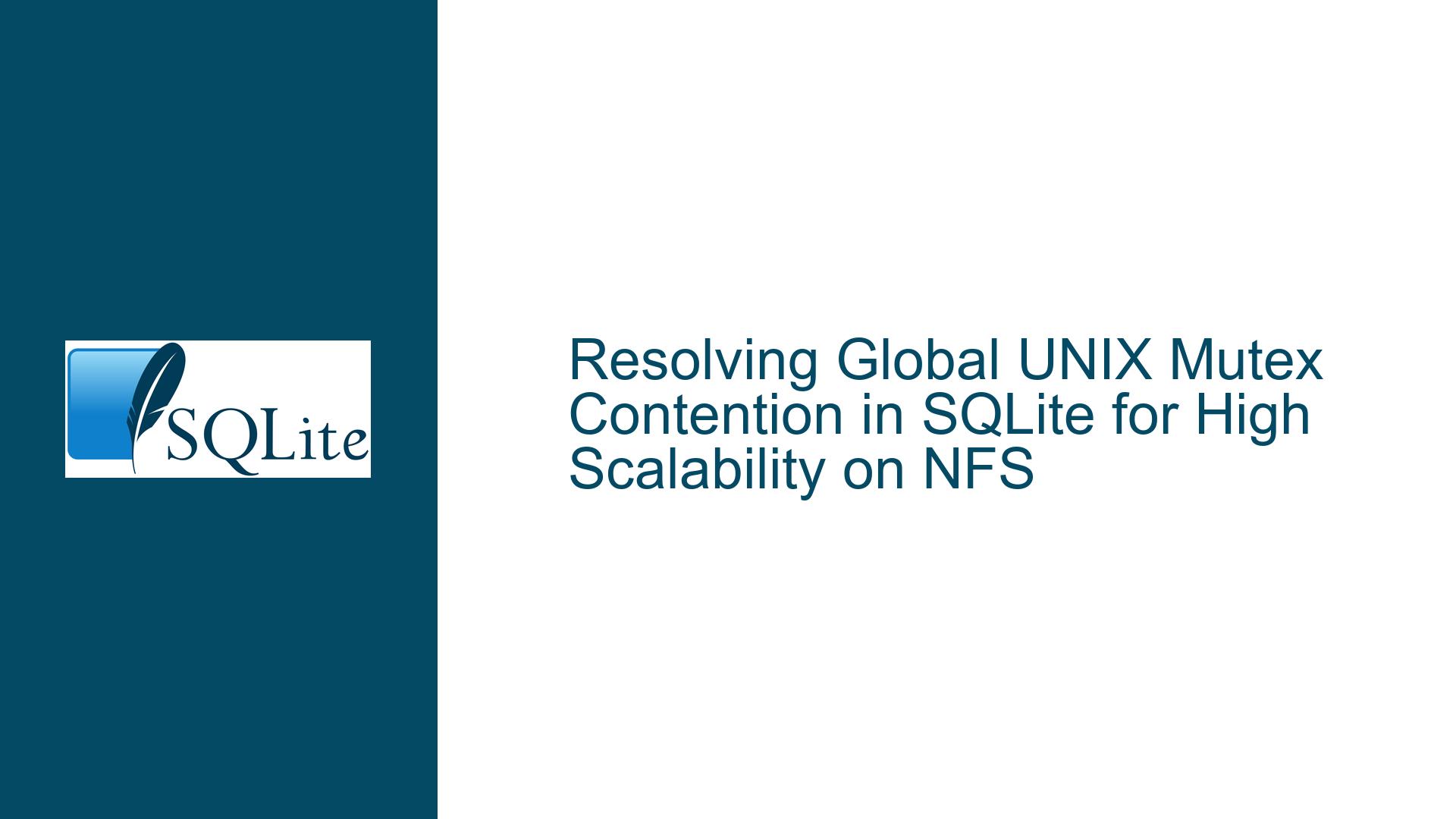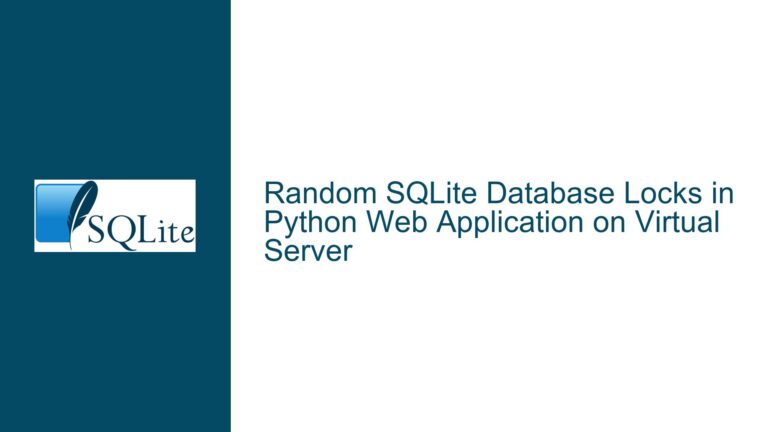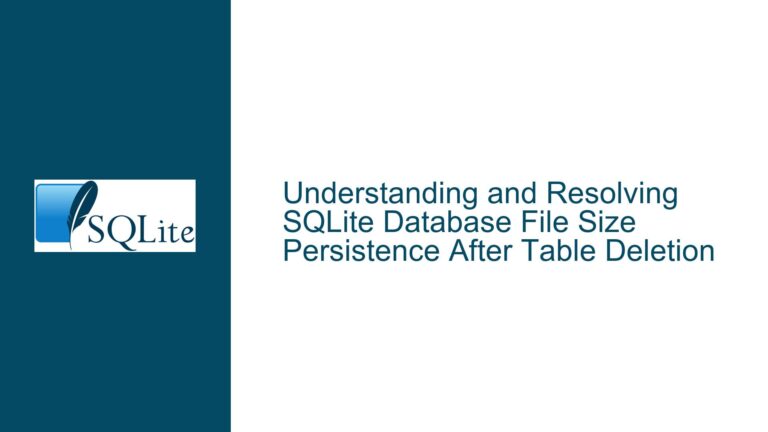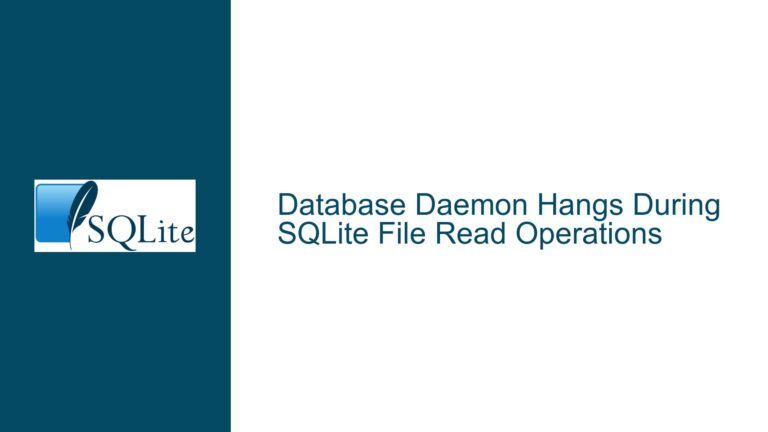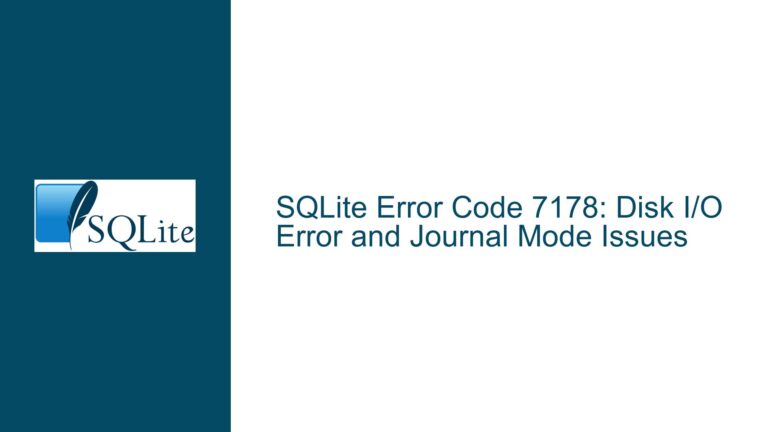Resolving Global UNIX Mutex Contention in SQLite for High Scalability on NFS
Global UNIX Mutex Contention in High-Concurrency SQLite Environments Over NFS
The core issue revolves around severe performance degradation when SQLite is used in applications requiring high-frequency opening and closing of database connections across thousands of machines, particularly when databases reside on NFS. The problem manifests as increased latency and reduced throughput due to contention around a global UNIX mutex that serializes operations related to inode management.
In SQLite’s UNIX VFS implementation, a single mutex (unixBigLock) guards a linked list of unixInodeInfo objects. These objects track file locks and shared state for open database files. Every database open/close operation must acquire this mutex, leading to serialization bottlenecks. When databases are hosted on NFS, operations such as stat(), fstat(), and file locking incur network latency, amplifying the time spent in the mutex’s critical section. Applications managing hundreds of thousands of databases per machine experience thread contention, with open/close latencies spiking to milliseconds under load.
The problem is exacerbated by two factors:
- NFS Overhead: File metadata operations (e.g.,
fstat) and advisory locks over NFS are orders of magnitude slower than local disk. - Global Mutex Granularity: A single mutex protects all inode-related operations, regardless of whether they target the same or different files.
A user-submitted patch replaces the linked list with a hash table of per-bucket mutexes, allowing concurrent operations on unrelated inodes. This change reduced latency by 80% and increased throughput by 5× in their testing.
Root Causes of Mutex-Induced Latency in Distributed File Systems
1. Serialized Inode Management via unixBigLock
SQLite’s UNIX VFS uses a global linked list (inodeList) to track unixInodeInfo objects, which store locking state and file identifiers (device + inode). The unixBigLock mutex guards this list, ensuring thread safety during insertions, deletions, and lookups. However, this design forces all threads—even those accessing unrelated databases—to contend for the same lock.
Critical Section Breakdown:
findInodeInfo(): Performsfstat()to get file metadata, searches theinodeListfor a matching entry, and creates a new entry if absent.releaseInodeInfo(): Decrements reference counts and removes entries frominodeListwhen no longer needed.- File Locking: Advisory locks (
fcntl()) are acquired/released within the same critical section.
Over NFS, each fstat() or fcntl() call involves network round-trips, extending the time the mutex is held.
2. NFS Latency Amplification
NFS imposes significant latency for metadata operations and locks due to:
- Network Round-Trips: Each
fstat()orfcntl()requires communication with the NFS server. - Server-Side Lock Management: NFSv3/v4 leases and lock recovery add overhead.
- Cache Coherency: Clients must frequently validate cached file attributes, triggering more network traffic.
While SQLite’s unix-none VFS can disable locking, this is unsafe for multi-process/multi-threaded write workloads.
3. High Frequency of Database Open/Close Operations
Applications managing large connection pools (e.g., 500,000+ databases per machine) open/close connections frequently to manage memory and file descriptors. Each operation acquires unixBigLock, creating contention spikes.
Optimizing Inode Locking and Mitigating NFS Overhead in SQLite
Step 1: Evaluate Locking Granularity
Replace Global Mutex with Sharded Locking
The user’s patch introduces a hash table with per-bucket mutexes, reducing contention:
Key Changes:
Hash Table Structure:
#define NBUCKET 13971 typedef struct inode_bucket_s { unixInodeInfo *node; pthread_mutex_t mutex; } inode_bucket_t; static inode_bucket_t g_inode_bucket[NBUCKET];Each bucket contains a linked list of inodes hashing to it, guarded by its own mutex.
Bucket Selection:
static inode_bucket_t* get_inode_bucket(unixFile *pFile) { return &g_inode_bucket[(pFile->st_dev * pFile->st_ino) % NBUCKET]; }Files with different device/inode pairs map to different buckets, enabling parallelism.
Concurrent Operations:
- Threads accessing unrelated buckets acquire different mutexes, eliminating contention.
- Inode insertion/removal is localized to a bucket.
Trade-Offs:
- Memory Overhead: 13,971 mutexes and bucket structures consume ~2–5 MB (varies by platform).
- Hash Collisions: Poorly distributed hashes could still cause contention.
Implementation Steps:
Backport the Patch:
- Apply the provided code changes to the SQLite amalgamation.
- Ensure
st_devandst_inoare stored inunixFile(added in the patch).
Benchmark:
- Measure open/close latency and throughput under load, comparing local disk vs. NFS.
- Validate thread scalability using tools like
sysbench.
Tune Hash Parameters:
- Adjust
NBUCKETto balance memory usage and collision probability.
- Adjust
Step 2: Mitigate NFS Latency
Alternative Storage Backends
- Ceph/RADOS: Use a distributed object store with local caching, avoiding NFS locking.
- SQLite’s
unix-noneVFS: Disable locks for read-only workloads:sqlite3_open_v2("file:data.db?nolock=1", &db, SQLITE_OPEN_READONLY, "unix-none");
NFS Tuning
- Use NFSv4.1+: Supports session trunking and parallel I/O.
- Tweak Mount Options:
mount -o vers=4.1,noac,hard,timeo=600,retrans=2noac: Disable attribute caching to reduce staleness checks.timeo=600: Increase timeout for retransmissions.
Step 3: Architectural Adjustments
Connection Pooling
- Reuse Connections: Cache open database handles instead of closing them.
- Limit Pool Size: Use LRU eviction to manage memory and file descriptors.
Database Sharding
- Merge Small Databases: Combine smaller databases into larger ones with partitioned tables.
- Lazy Closing: Defer close operations during low activity.
Step 4: Collaborate with SQLite Developers
Upstreaming the Patch
- Refine Code Quality:
- Replace
printf/abort()with SQLite’s error-handling macros. - Ensure thread safety without relying on platform-specific
pthread_mutex_t.
- Replace
- Submit via Fossil: Follow SQLite’s contribution guidelines.
Commercial Support
Engage SQLite’s developers through paid support to prioritize the fix.
Step 5: Fallback Strategies
Custom VFS Implementation
Develop a lightweight VFS that bypasses unixBigLock for inode management:
- Bypass
inodeList: Track inodes per-file or use thread-local storage. - Atomic Reference Counting: Use
atomic_intfornRefinstead of mutexes.
Fork SQLite
Maintain a patched version with sharded inode locks, merging upstream updates periodically.
Conclusion
The global unixBigLock mutex becomes a severe bottleneck in SQLite deployments requiring high-frequency database open/close operations over NFS. Replacing it with a sharded locking mechanism reduces contention and improves scalability. While the proposed patch demonstrates significant gains, its adoption upstream requires refinement to meet SQLite’s coding standards and portability requirements. In the interim, combining connection pooling, NFS tuning, and custom VFS implementations can mitigate the issue.
